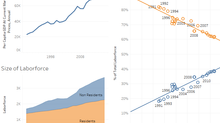Singapore in Numbers - Household incomes post pandemic
After 2 years of social restrictions due to the COVID19 pandemic, Singapore is finally easing almost all social restrictions. As at May 2022, short of the requirement to wear masks in enclosed areas, Singapore residents can pretty much resume all social activities like they did before the pandemic. While that is good news, but the 2 years of restrictions had taken its toll on the financial wellbeing of many households. As Singapore adapts to the new post pandemic norms, FYT thought that it would be a good idea to take stock of the impact that the pandemic had on household incomes.
Between 2019 and 2021, the Singapore economy faced huge challenges. For a time, many businesses could not to operate by law; and when they were allowed to, many had to adapt to constantlyt evolving pandemic rules and restrictions. For those who were too slow, unable to unwilling to adapt, many had to downsize or wind up their business. No surprise that many Singapore residents faced uncertainty and losses to their incomes and made it difficult to support their families basic daily needs. In responde, the government introduced sizable financial support programmes to help families and businesses cope. But the challenges were not local in nature, the pandemic also impacted the economies around the world; which led to rising prices across the board.
Data suggests that not all households fared too badly over the pandemic. Between 2019 and 2021,
Household incomes among the top three deciles (70th to 100th) fell by varying degrees.
The larget drop was among the top decile whose income fell by 7.3%; bearing in mind that this still amounted to over $28,000 per month.
Household incomes for most of the lower deciles grew by 1.8% and 5+%; with the exception of the lowest and the 21st to 30th percentile whose income fell.
However household incomes may not reveal an accurate picture of the financial impact on households, since households vary in size and thus the available resources per member would show a more accurate picture.
Despite the variance in household incomes across deciles, the household income per person grew over the pandemic across most deciles. Most grew between 1.2% to almost 4% between 2019 - 2021
Only 2 deciles showed a drop in household incomes; specifically, the lowest and top deciles.
At face value, the data suggests that most households in Singapore came out of the pandemic relatively unscathed. It was claos clear that the lowest deciles suffered the biggest losses; they already had the least financial resources per person and suffered further reductions between 2019 and 2021.
But absolute household income growth doesn't tell the whole story as well. We must also consider what the Singapore could buy in 2021. Singapore consumer price index showed that prices rose by 2% on average across all items. That suggests that household incomes across outgrew the increases in prices, especially for those in the lower deciles (2nd to 6th); however, those in the lowest deciles are be worse off. However, the price increases varied quite significantly by category
The sharpest price increases was among private land transportation (cars, motorcycles, petrol, bus & train fares etc.). Prices of motorcycles rose by almost 40% vs 2019; which could have a significant impact on the delivery riders who eked out a living during the pandemic
Food prices also rose significantly, between 10-15% for meats and vegetables. This would have a a borader impact across Singapore; and the lower household income deciles would feel it more
That said, prices did fall for some of the items; such as Clothing, Footwear, Medicines, and Vitamins
Bearing in mind that this data snapshot is dated 2021, many notable events happened in 2022; specifically,
The war in Ukraine and the related economic sanctions on Russia which have disrupted global markets and driven prices even higher
Growing inflation across many developed nations, prompting many central banks to raise interest rates; which is likely to raise prices further
While Singapore may have started out 2022 in relatively good shape, all things considered; but 2022 brings with it a lot of uncertainty. Having a good start is still a much better place than many other countries have had to contend with.
Click the image to get access to the interactive data visualizations and explore for yourself.


























Comments